See also:
- Zucchini Yellow Mosaic Virus Found Most Commonly Affecting Pumpkins and Squash with Viral Symptoms in 2022
- LIHREC Virus diseases of cucurbits photo gallery (includes additional information)
Viruses are among the more common causes of diseases affecting cucurbits in New York. These diseases result in losses through reduction in growth and yield and are responsible for distortion and mottling of fruit, making the product unmarketable. A complex of viruses is able to infect cucurbits, a plant group that includes cucumber, melon, squash, pumpkins, and watermelon. The most important viruses are cucumber mosaic virus (CMV), squash mosaic virus (SqMV), Cucurbit–Papaya Ringspot Potyvirus, watermelon mosaic virus (WMV), and zucchini yellow mosaic virus (ZYMV). With the exception of SqMV, which is seedborne in melon and transmitted by beetles, the other major viruses are transmitted by several aphid species in a nonpersistent manner.
On this page:
Major Cucurbit Viruses:
- Cucumber mosaic virus (CMV)
- Watermelon mosaic virus (WMV)
- Squash mosaic virus (SqMV)
- Cucurbit–Papaya ringspot potyvirus (PRSV)
- Zucchini yellow mosaic virus (ZYMV)
Minor Cucurbit Viruses and Disease Agents:
- Tobacco ringspot virus (TRSV)
- Tomato ringspot virus (TmRSV)
- Clover yellow vein virus (CYVV)
- Aster yellows (viral-like disease caused by a phytoplasma)
Cucumber mosaic virus (CMV)
Cucumber mosaic virus (CMV) is probably the most widely distributed and important virus disease of cucurbits in New York. The virus overwinters in many perennial weed sources especially attractive to aphids when weed growth resumes in the spring. Early infection of squash and melons is particularly common. Aphids are the main and most efficient method of virus spread. Summer squash displays severe downward cupping along the midvein and leaf reduction from which the plants fail to recover. Color breaking of squash fruit is usually seen, but is not unique for this virus; other viruses causing this symptom include watermelon mosaic virus, squash mosaic virus, and zucchini yellow mosaic virus. Early decline of muskmelon vines is usually attributed to CMV infection and should not be confused with collapse or “sudden wilt,” which is a more complex disease and a plant-stress-related syndrome. CMV may be seedborne to a limited extent in some crops and weeds such as common chickweed (Stellaria media). There are genetically enhanced varieties of yellow summer squash and zucchini with a high degree of resistance to CMV as well as WMV and ZYMV. Good CMV-resistant (actually tolerant since plants are infected by the virus) cucumber varieties are commercially available and produce a high percentage of unmottled fruit. All other commercially grown cucurbits are susceptible to CMV, although in yellow summer squash varieties that also carry a “precocious yellow gene”, this gene serves to mask the color breaking common with cucurbit viruses (see discussion under WMV).
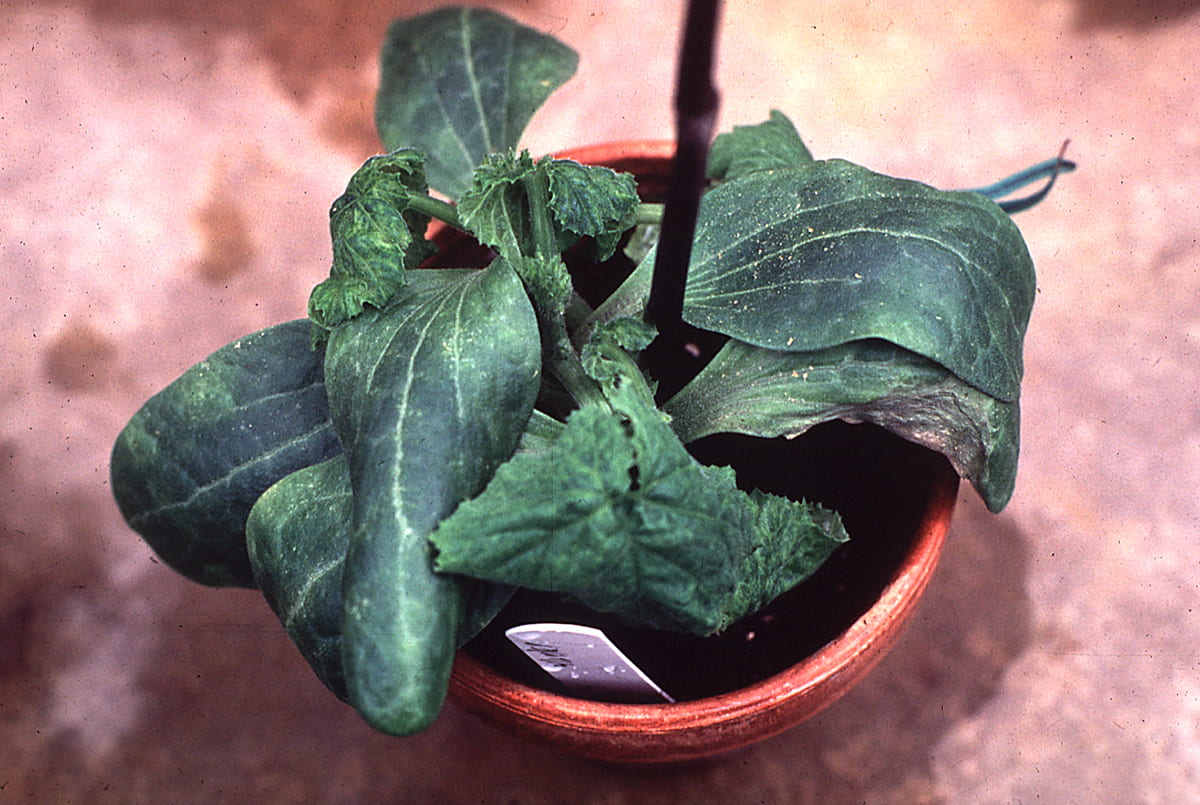

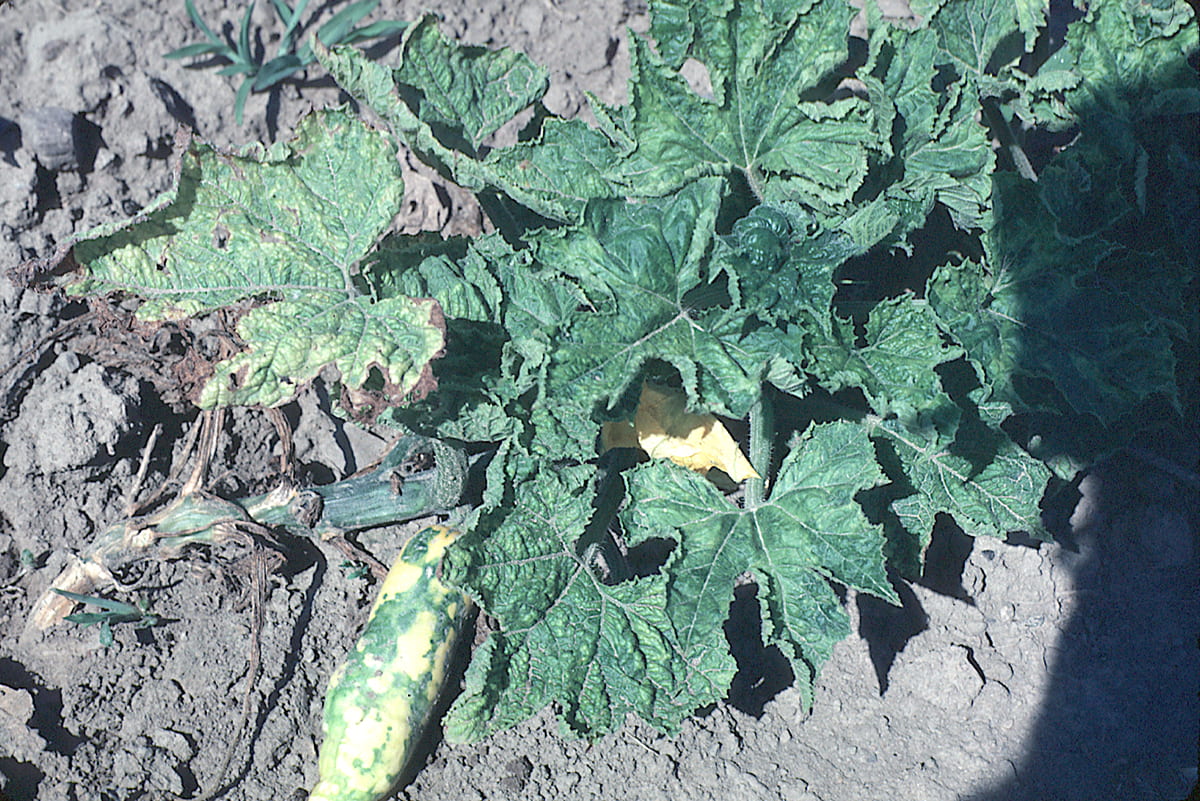
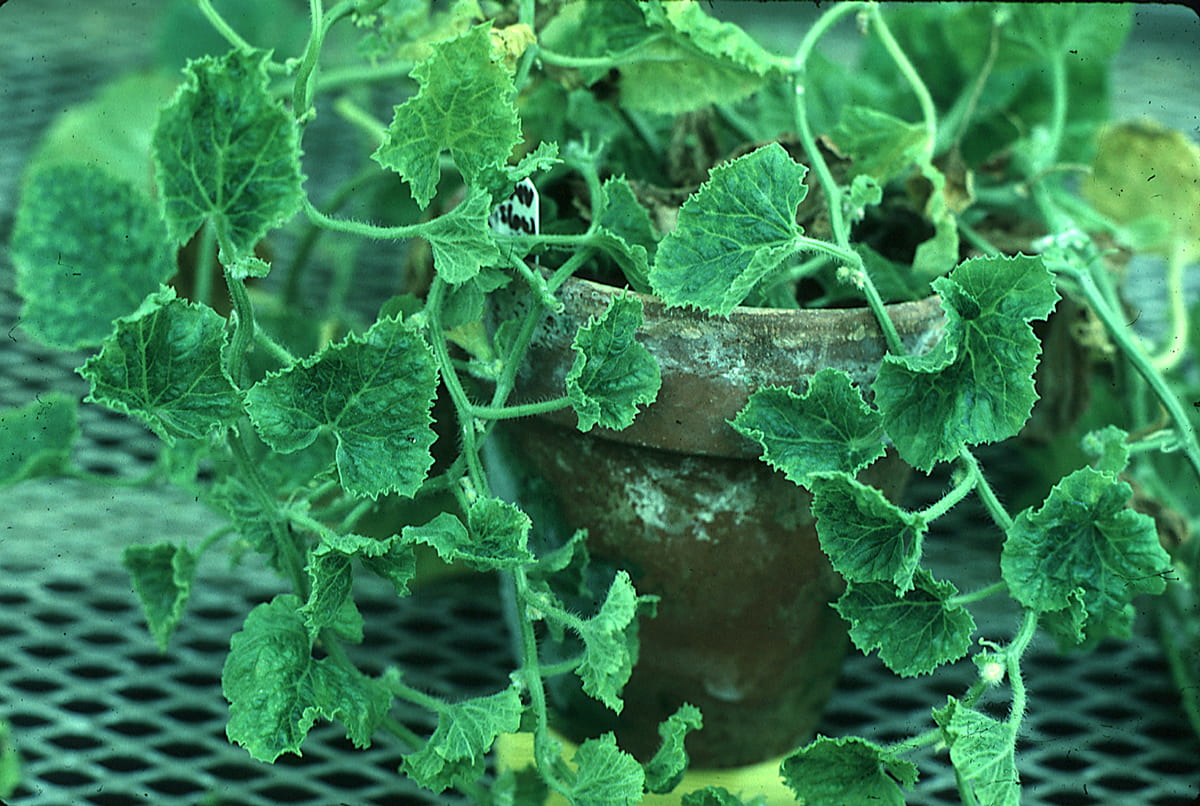
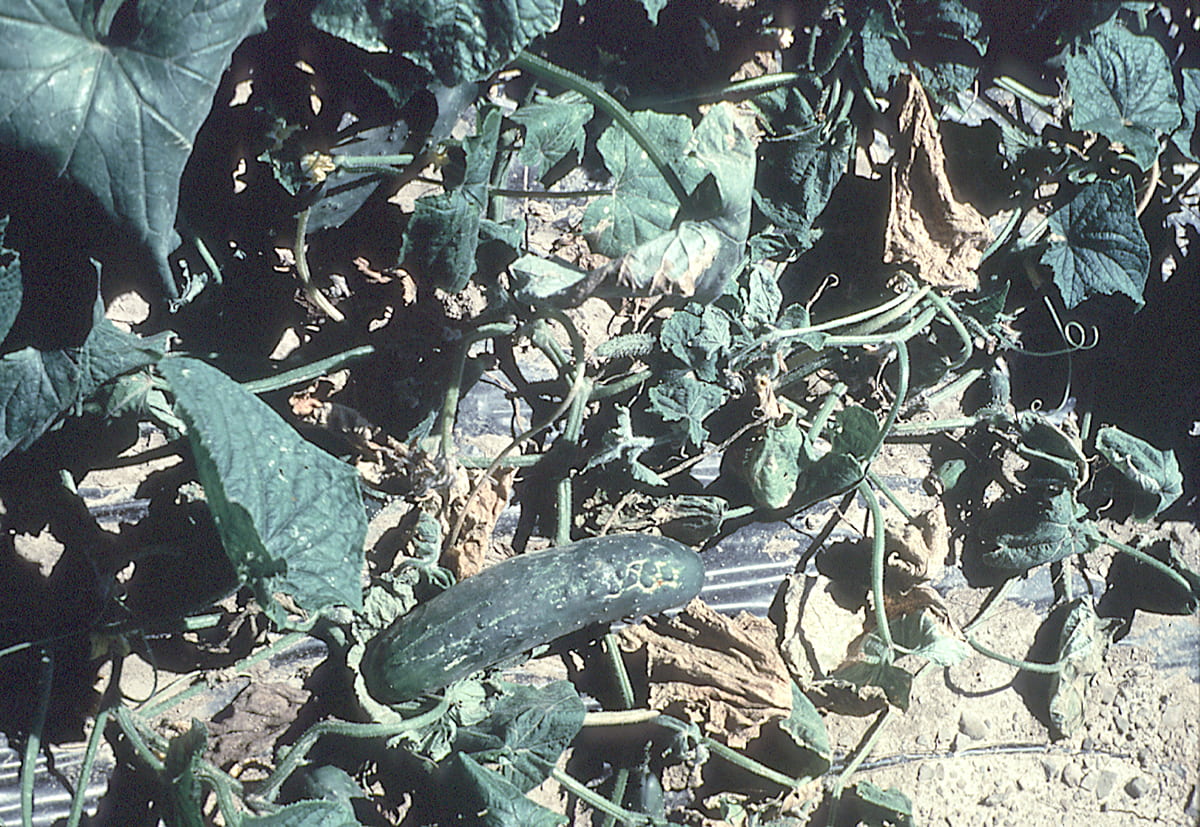
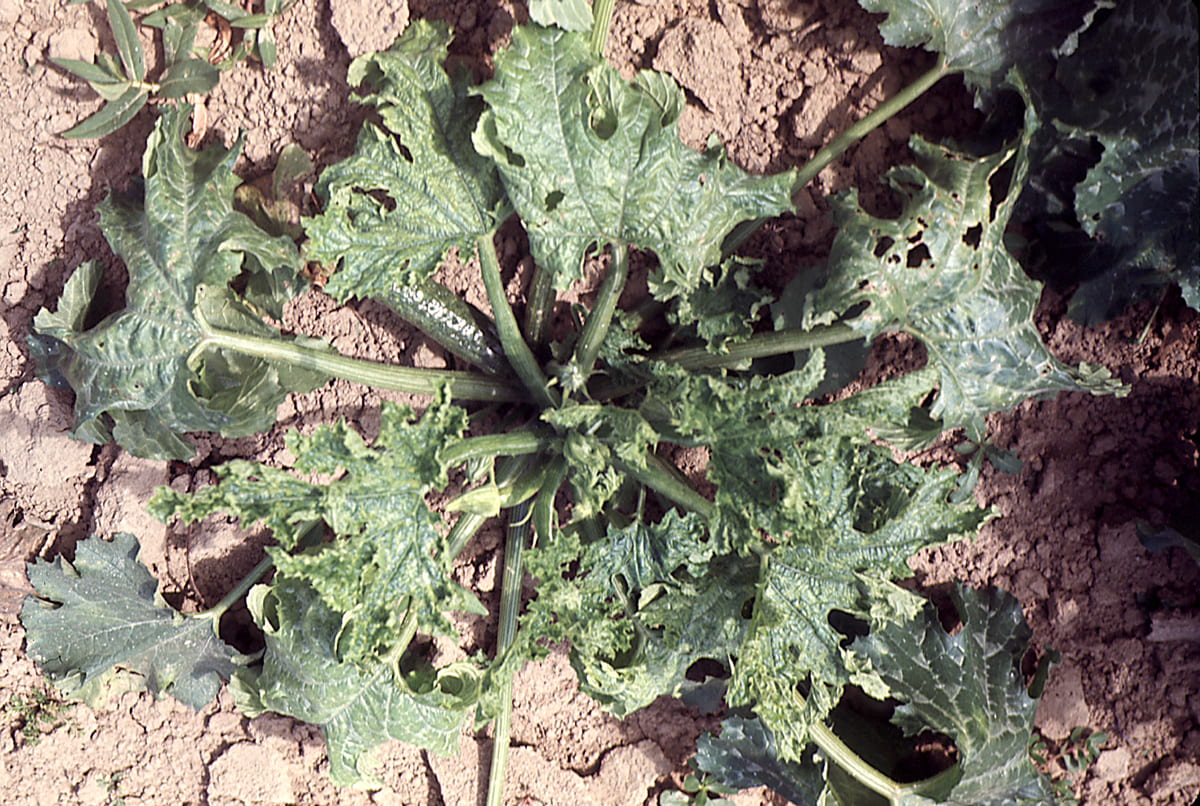
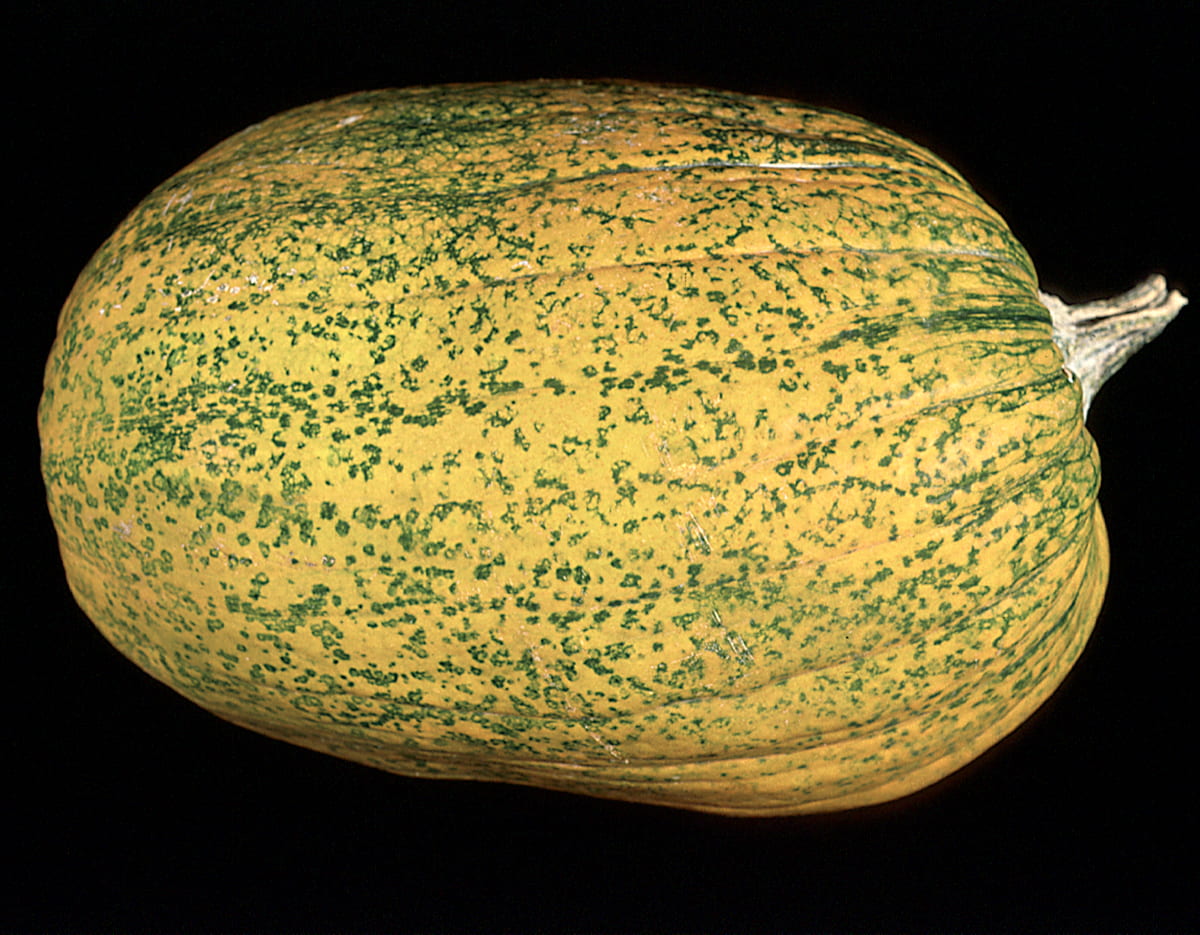
Watermelon mosaic virus (WMV)
Watermelon mosaic virus (WMV) is the second most important cucurbit virus in New York. This virus can infect and produce symptoms on all commercially grown cucurbits. This aphid-transmitted virus causes milder symptoms on the foliage of most infected plants like squash, and growers have seen a lessening of foliar symptoms following fertilization. Fruit distortion and color breaking are still a problem on yellow summer squash and zucchini. There are genetically enhanced varieties of these cucurbit crop types with a high degree of resistance to WMV as well as CMV and ZYMV. Varieties such as ‘Multipik’ with the “precocious yellow gene” can prolong the harvest period because the fruit are marketable in spite of foliar symptoms. The host range for WMV is not limited to cucurbits, thus opening the possible overwintering of this virus in several leguminous species such as clover. Mixed infections of cucurbits with CMV and WMV are common by the end of the season. WMV was formerly called Watermelon mosaic virus 2 (WMV-2).
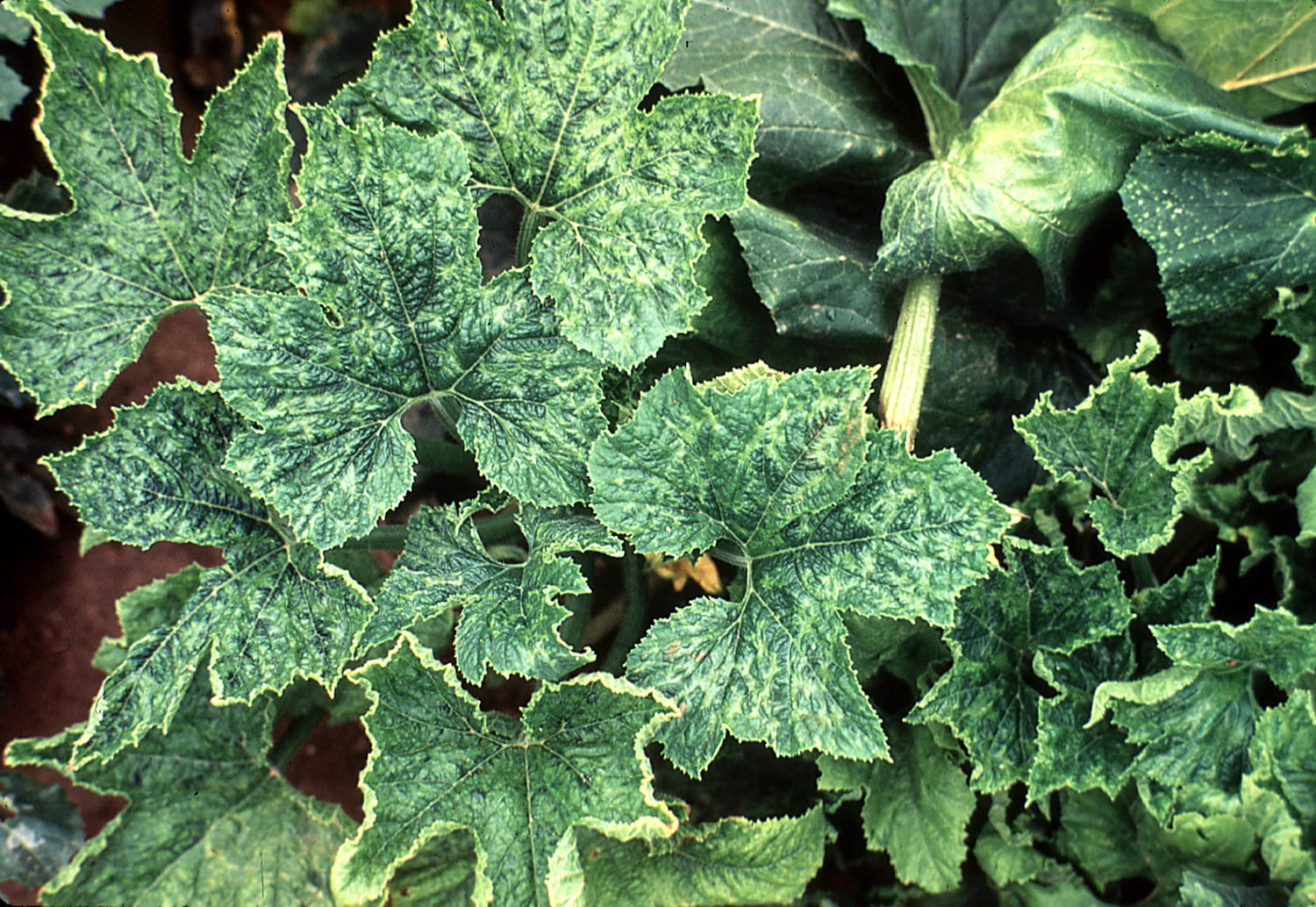

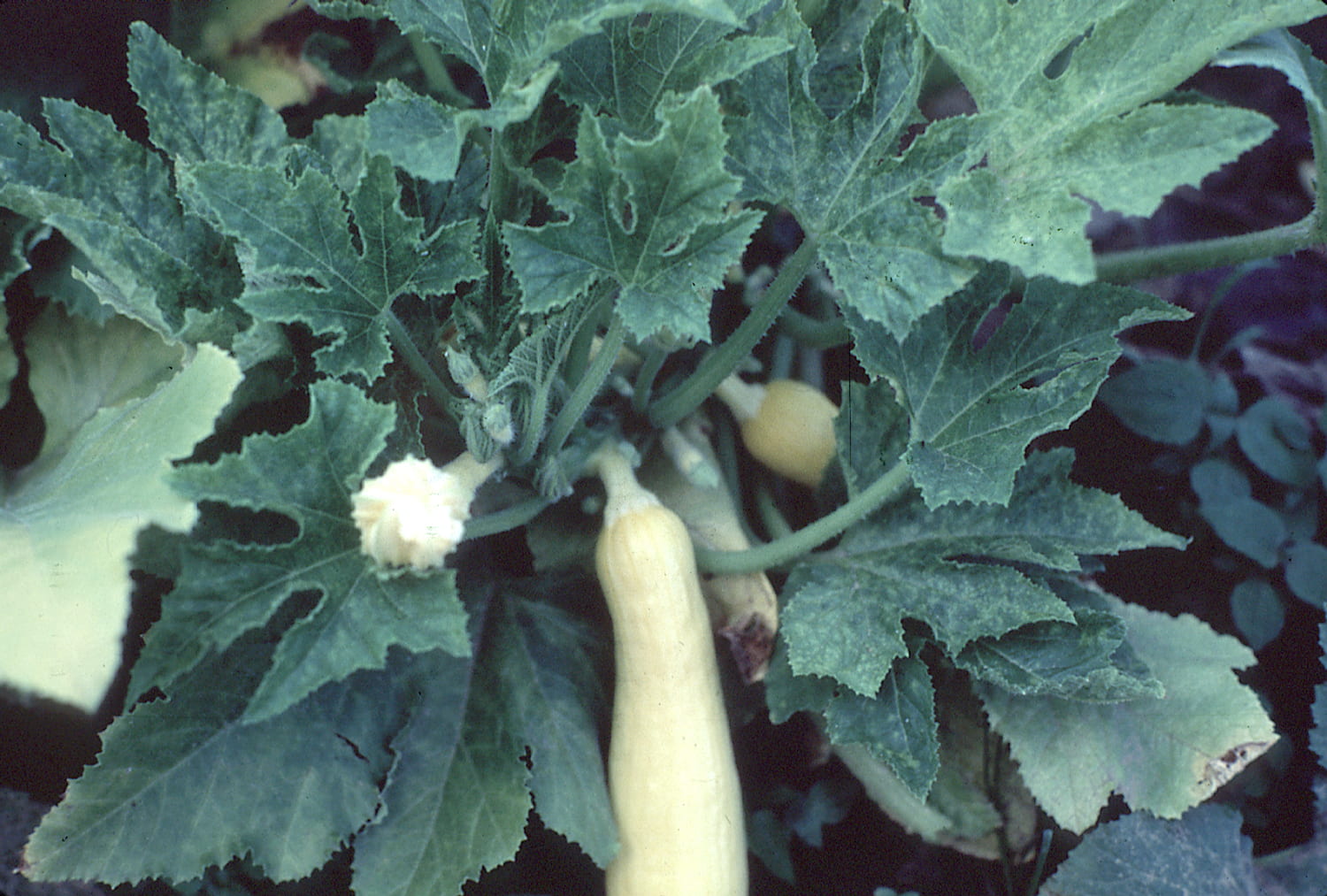
Squash mosaic virus (SqMV)
Squash mosaic virus (SqMV) can cause an important disease of melons and squash in New York. The virus is seedborne in muskmelon and is spread in nature principally by the spotted and striped cucumber beetles. The virus is carried within the seed and cannot be eliminated by hot water or chemical treatment with trisodium phosphate.
Symptoms consist of pronounced chlorotic mottle, green veinbanding, and distortion of leaves of young seedlings. On mature plants, leaves show intense dark green mosaic, blistering, and hardening, suggestive of a hormonal herbicide effect (first image below). Infected fruit coming from such plants show a strong mottled pattern with a lack of netting on melons (second image below). Control measures include selection of disease-free seed and cucumber beetle control.
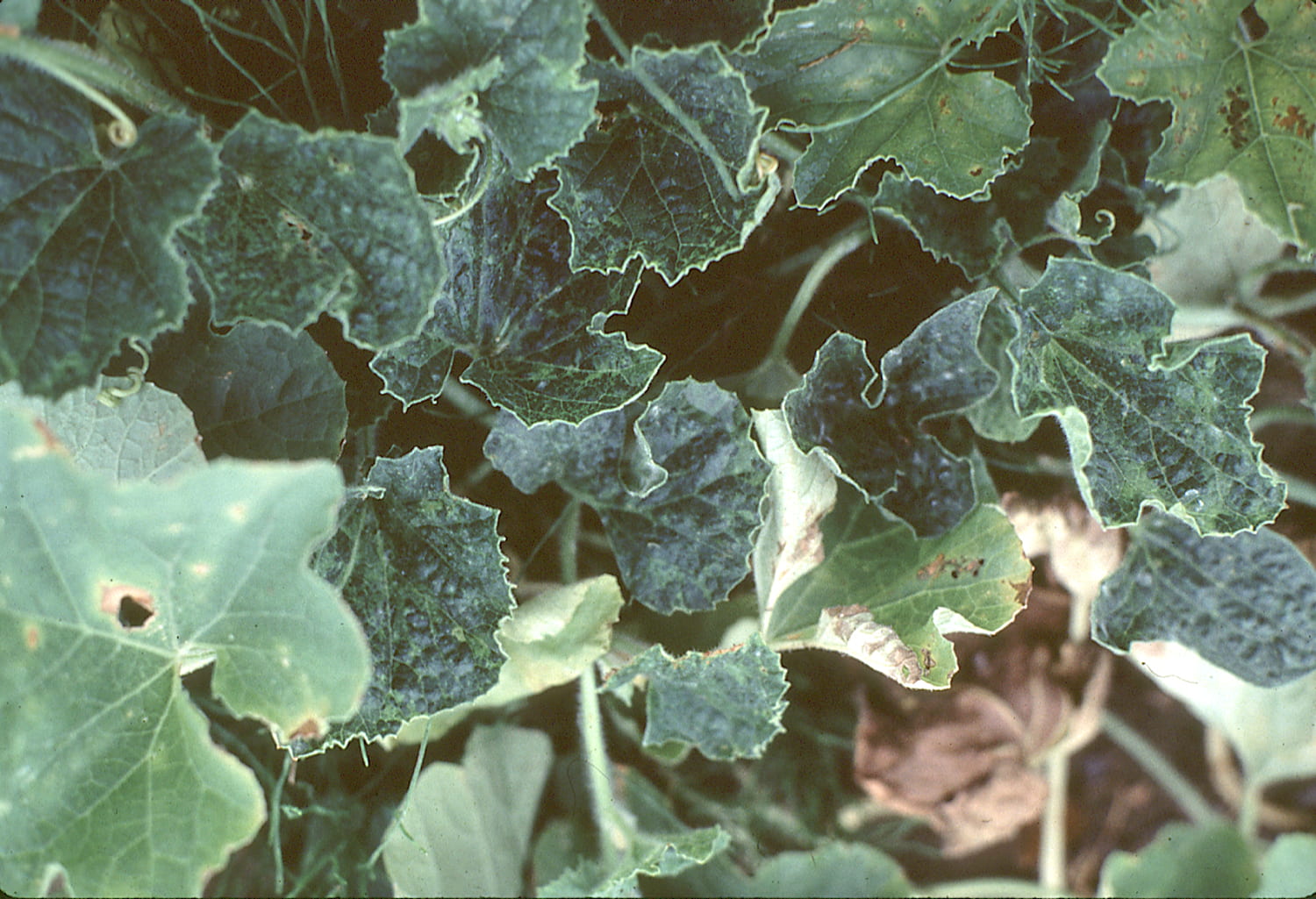
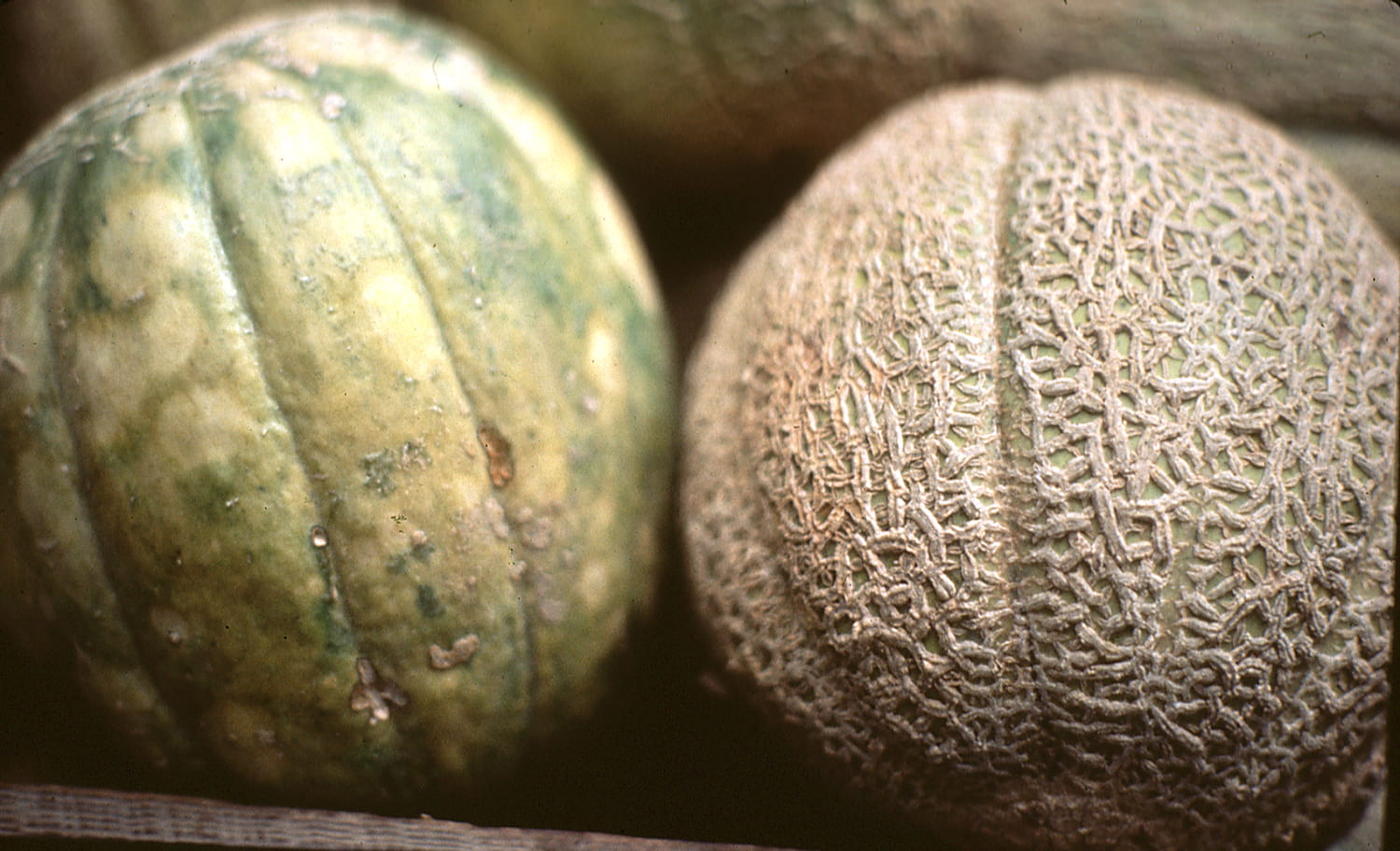
Cucurbit–Papaya Ringspot Potyvirus (PRSV)
Cucurbit–Papaya Ringspot Potyvirus (formerly Watermelon Mosaic Virus 1, WMV-1) is aphid transmitted. Although more common in the southern and western regions of the United States, this virus has been recovered in New York several times since it first occurred in epidemic proportions in 1969. This virus is capable of infecting all commercial cucurbit crops. The foliage of affected plants shows strong mosaic, distortion, and deep leaf serration. Fruits are also malformed with knobby overgrowth and color breaks.

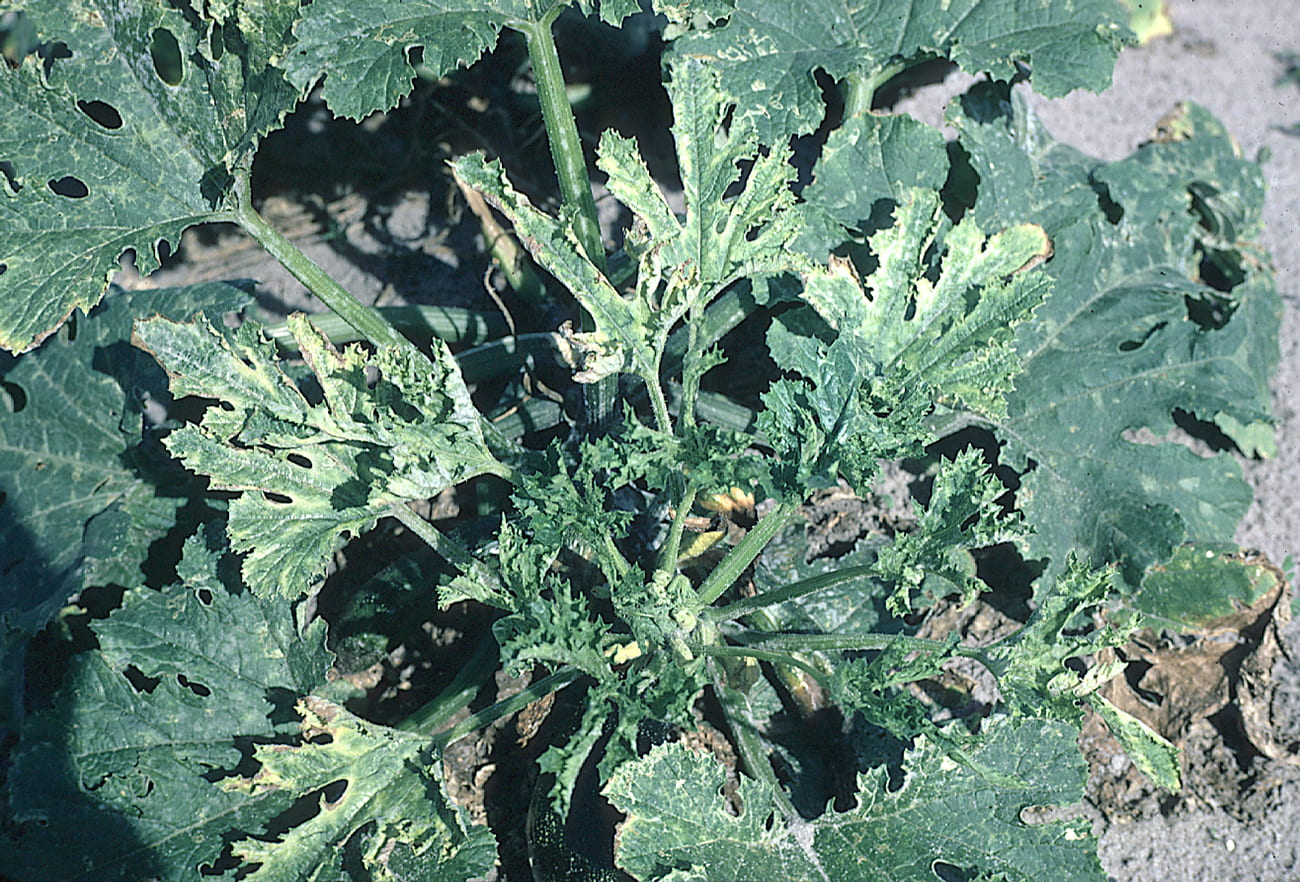
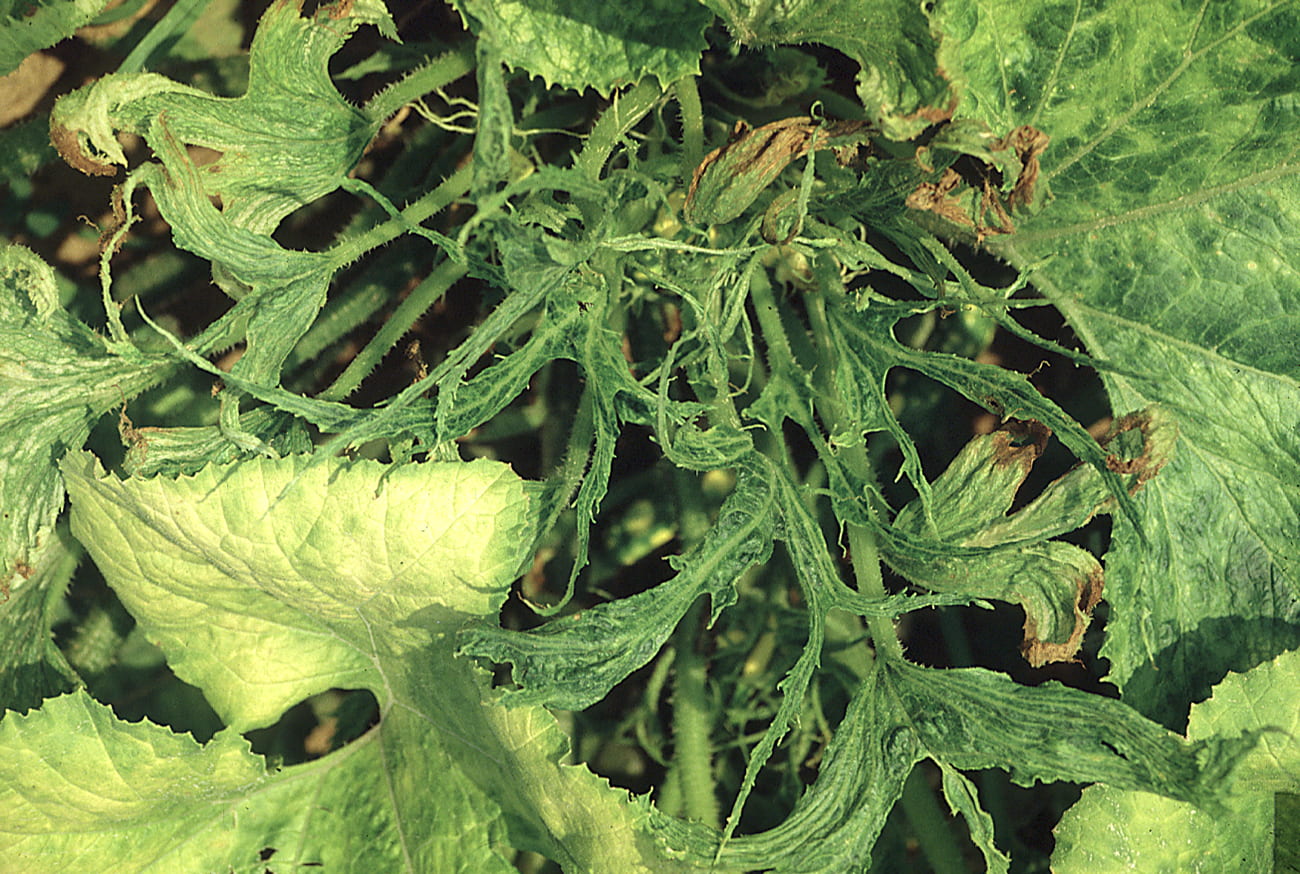

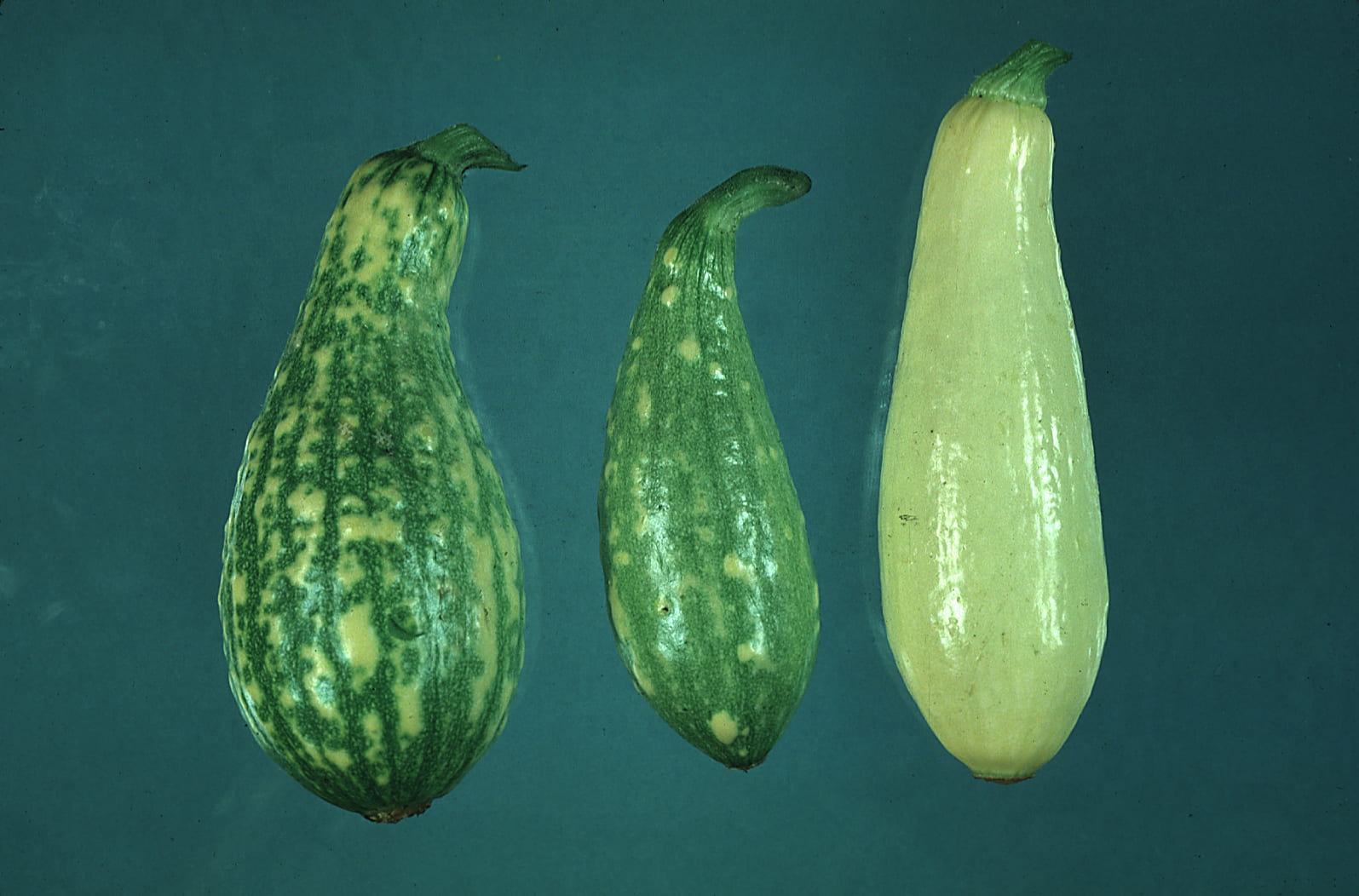
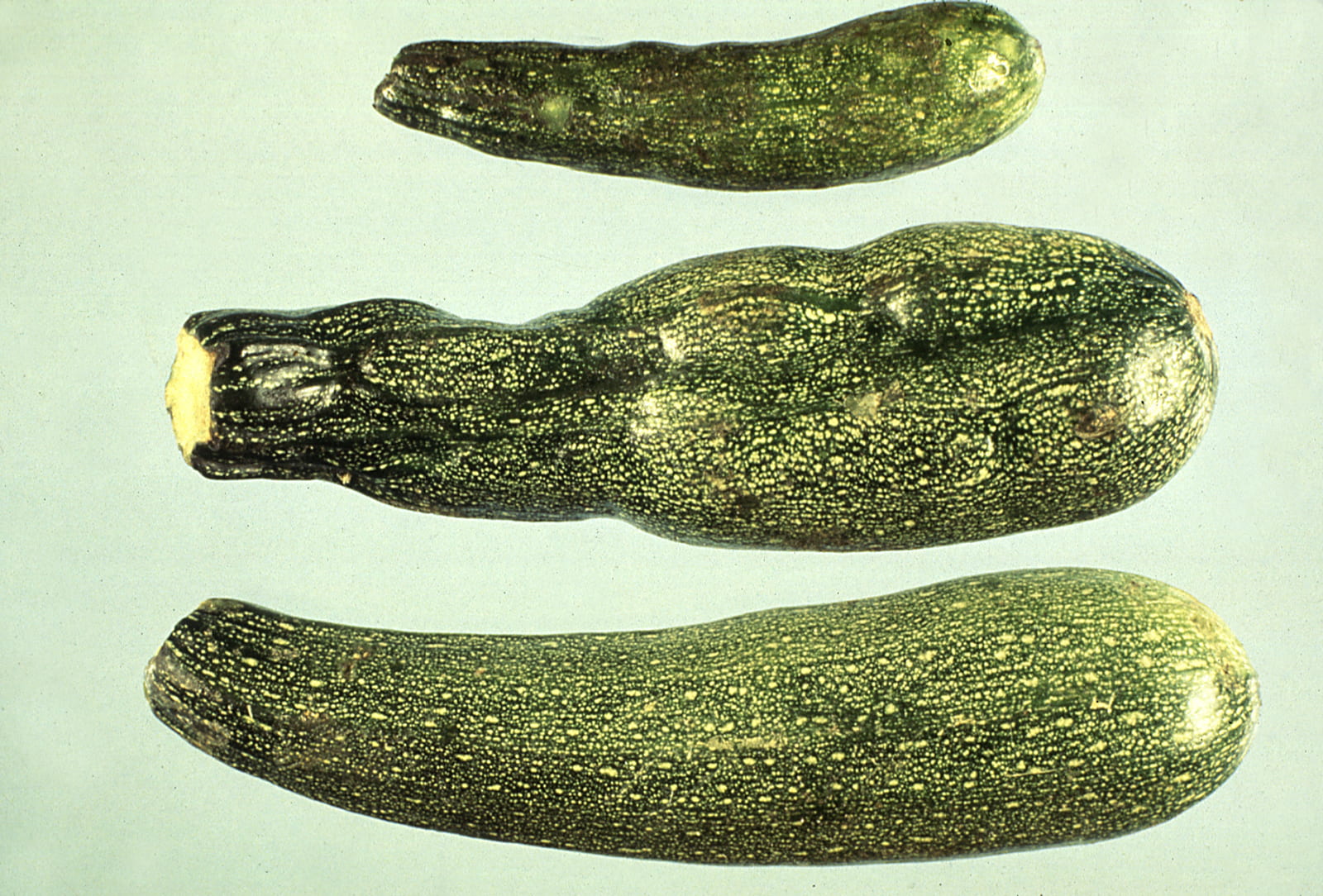
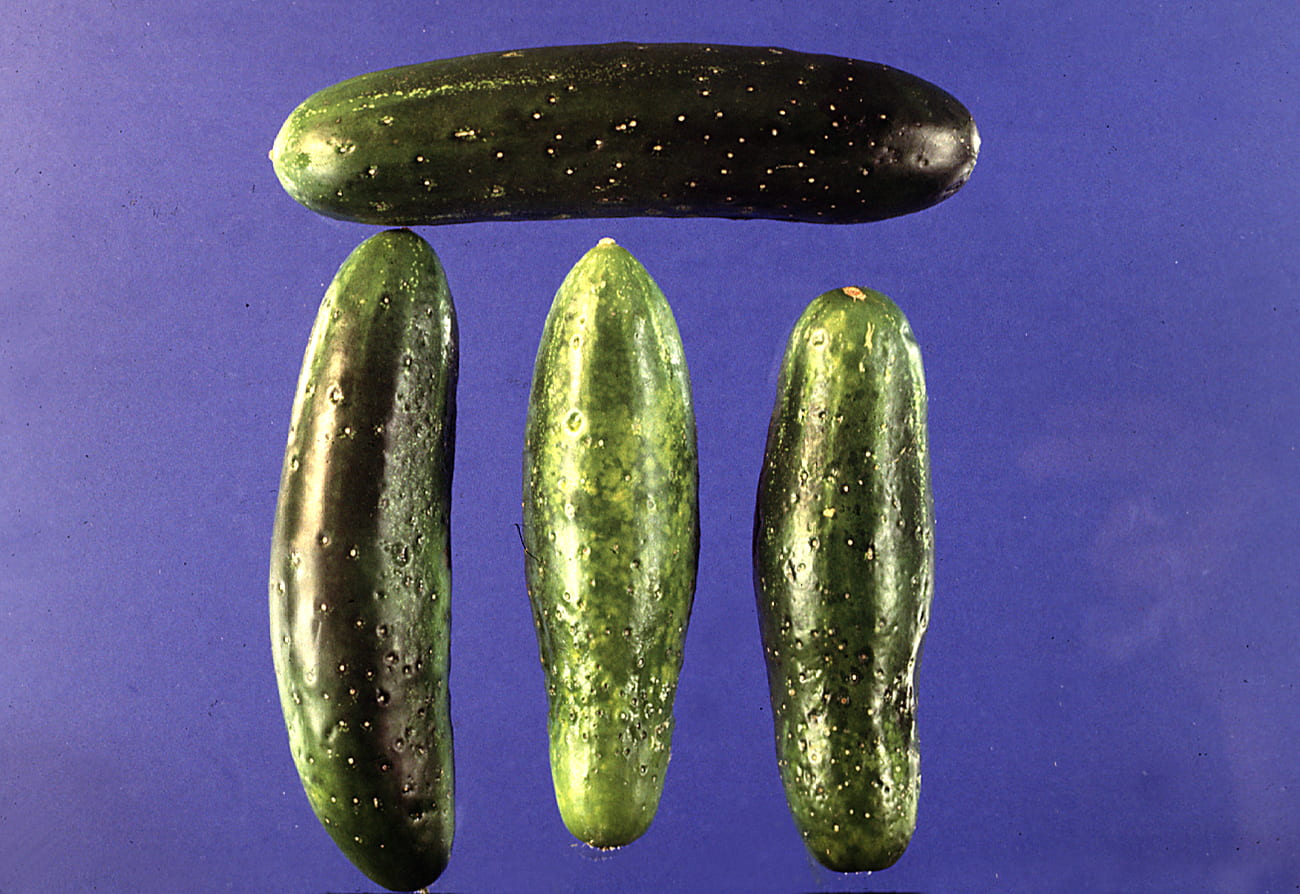
Zucchini yellow mosaic virus (ZYMV)
Zucchini yellow mosaic virus (ZYMV) is a relatively recently described virus disease of cucurbits, first identified in Europe in 1981. It has since been reported from most southern and southwestern states and was found in New York State in 1983. The virus has characteristics very similar to PRSV and WMV (nonpersistent aphid transmission, etc.), and like WMV, its host range is not limited to cucurbits. Muskmelon, watermelon, and squash are severely affected by ZYMV. Foliar symptoms consist of a prominent yellow mosaic, necrosis, distortion, and stunting. Fruits remain small, greatly malformed, and green mottled, including fruit of the variety ‘Multipik’. Weeds may serve as hosts enabling overwintering of this virus in New York. There are genetically enhanced varieties of yellow summer squash and zucchini with a high degree of resistance to ZYMV as well as CMV and WMV.
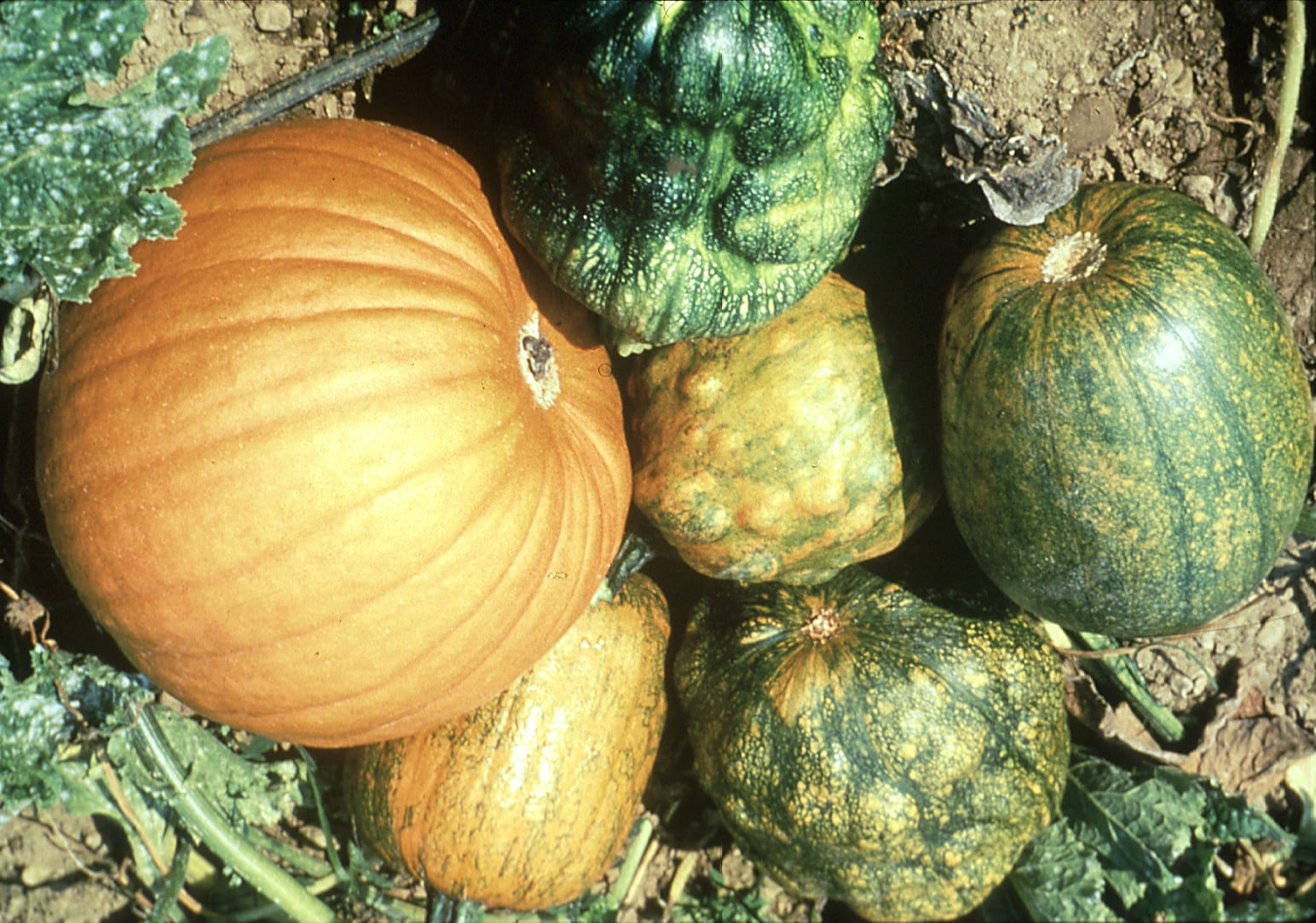
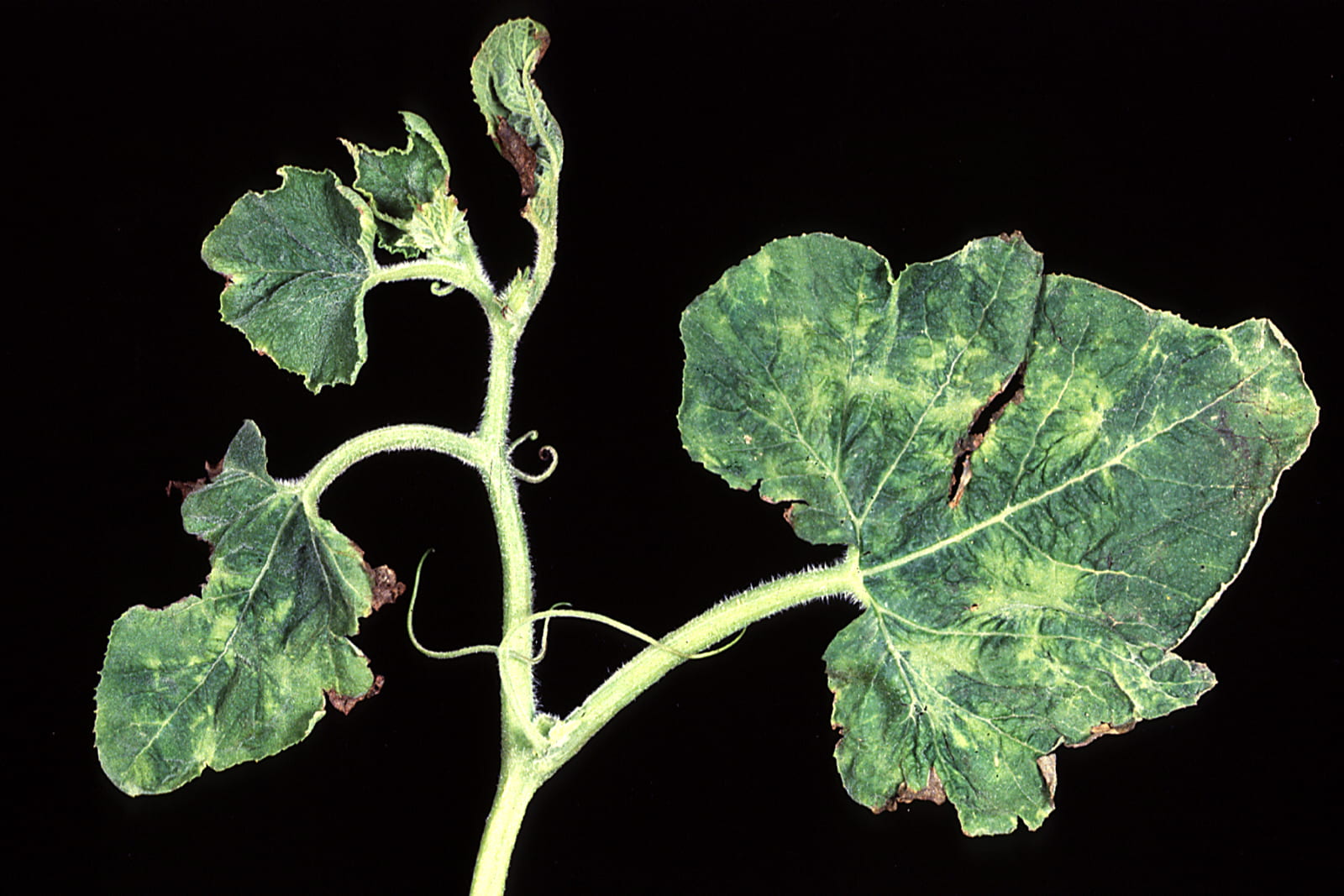
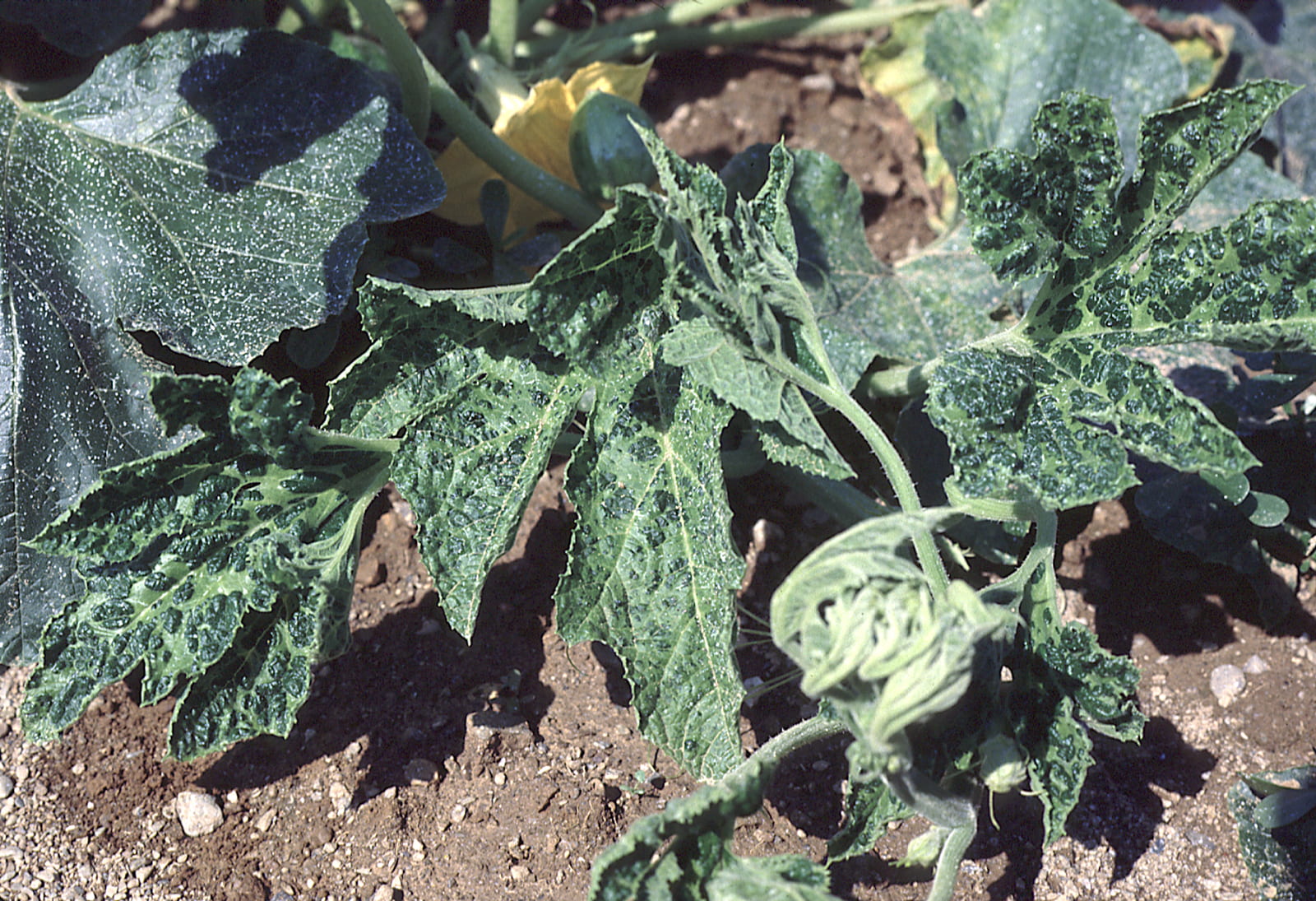
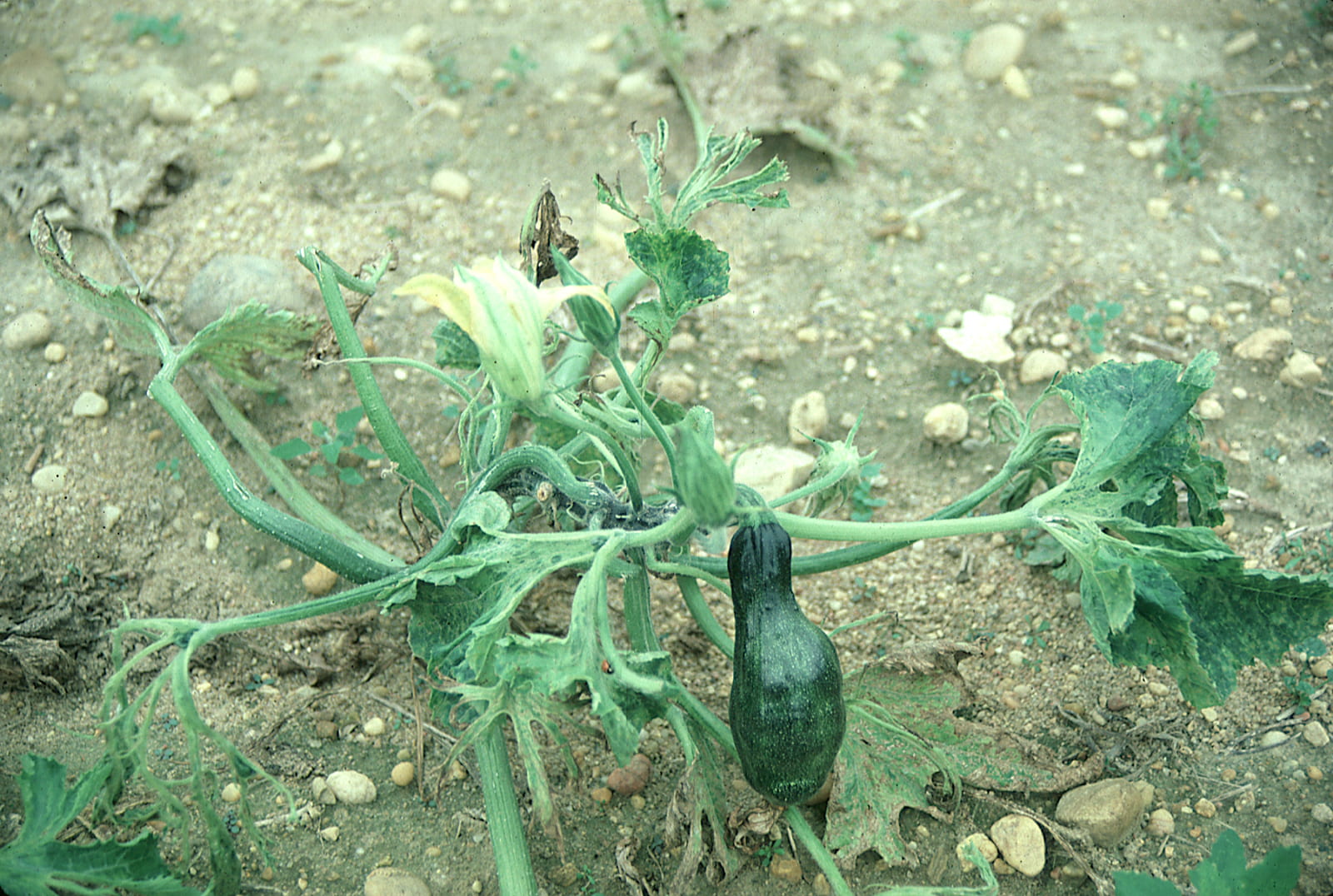
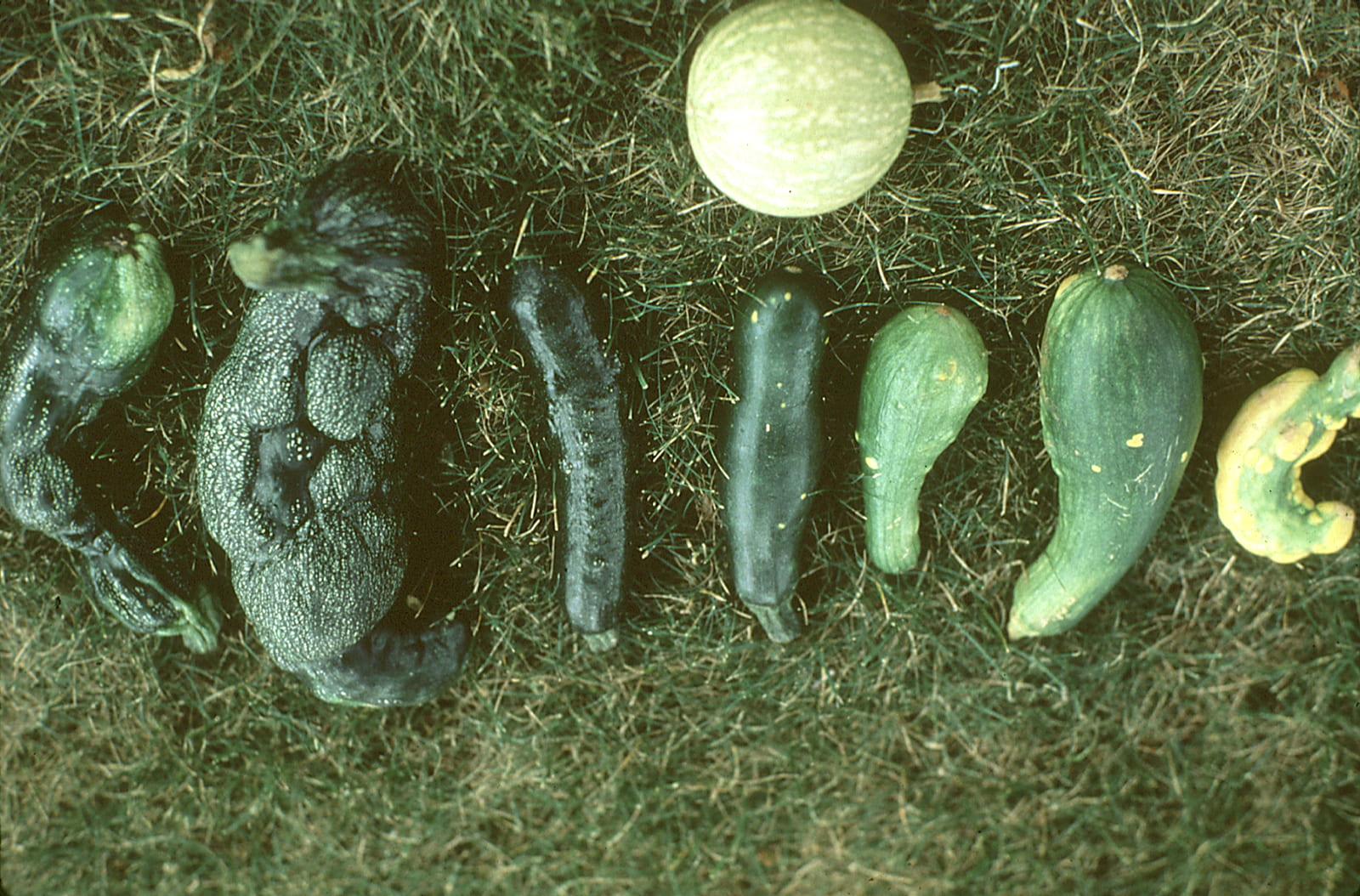
Tobacco ringspot virus (TRSV)
Tobacco ringspot virus (TRSV) is mainly transmitted by nematodes (Xiphinema americanun). Melons and cucumbers are most commonly affected by this virus. The virus has been known on rare occasions to be seedborne in cucurbits. The newly infected leaves show a very bright mosaic with plant stunting (below). But subsequent leaves are reduced in size and develop a dark green color.

Tomato ringspot virus (TRSV)
Tomato ringspot virus (TmRSV) causes severe damage to summer and winter squash, but shows only mild symptoms in the other cultivated cucurbits. Like TRSV, TmRSV is nematode transmitted and can be overwintered on many weed species without expressing symptoms.
Clover yellow vein virus (CYVV)
Clover yellow vein virus (CYVV) is an aphid- transmitted virus that can infect summer squash and was previously considered to be the severe strain of bean yellow mosaic virus. The virus produces a yellow specking on the foliage of infected plants.
Aster yellows
Aster yellows was originally thought to be caused by a virus. The causal phytoplasma, which is transmitted by leafhoppers, has been recovered from infected squash in New York. It causes plants to become yellow and stunted.
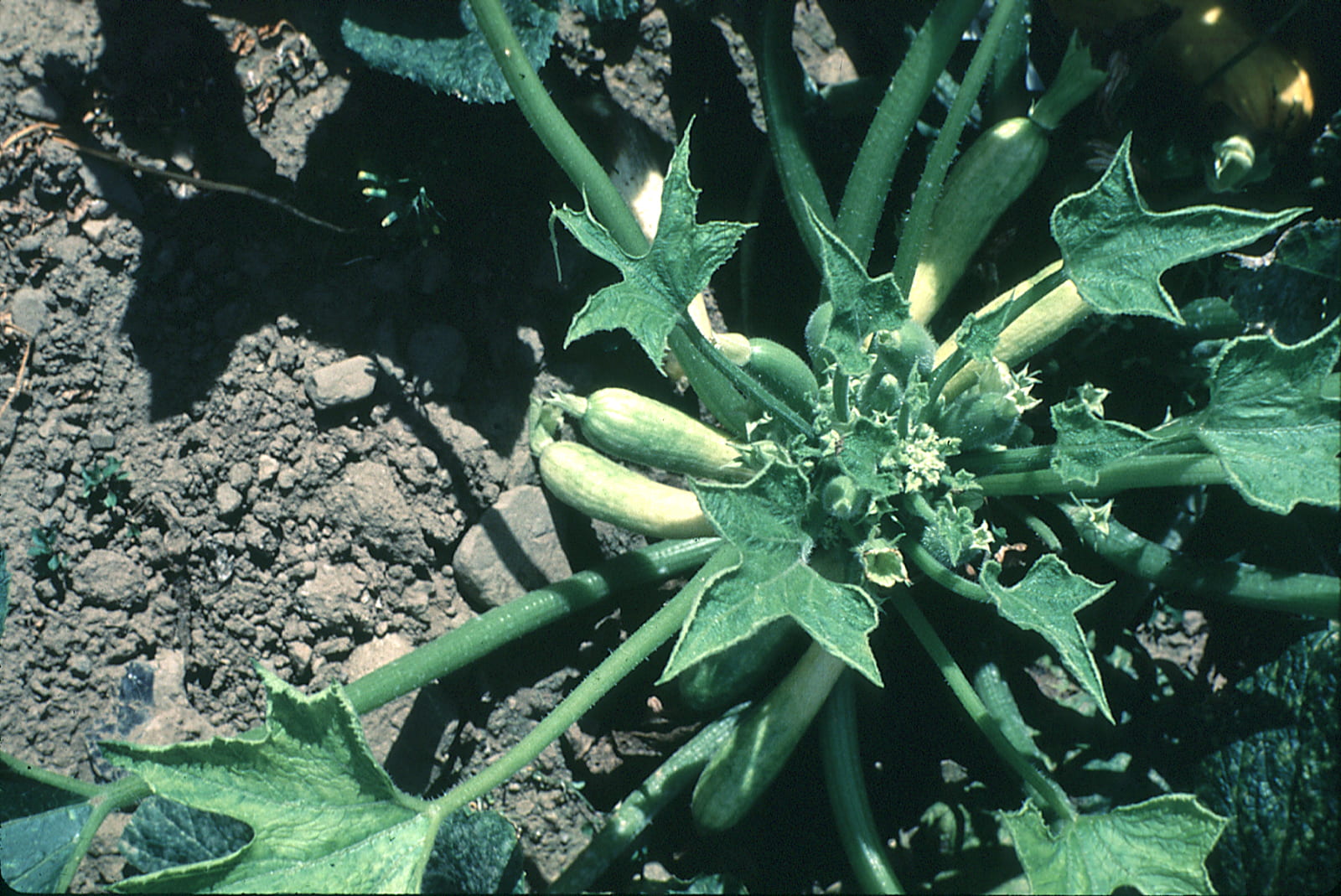
More information:
Margaret Tuttle McGrath
Associate Professor Emeritus
Long Island Horticultural Research and Extension Center (LIHREC)
Plant Pathology and Plant-Microbe Biology Section
School of Integrative Plant Science
College of Agriculture and Life Sciences
Cornell University
mtm3@cornell.edu
Updated February 2021
Originally prepared for Vegetable MD Online by T. A. Zitter and M. T. Banik, Dept. of Plant Pathology, Cornell University, and R. Provvidenti, Dept. of Plant Pathology, New York State Agricultural Experiment Station, Geneva.


